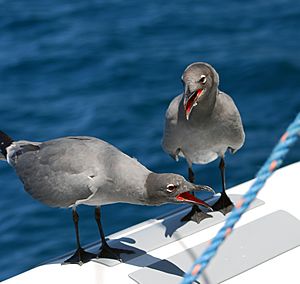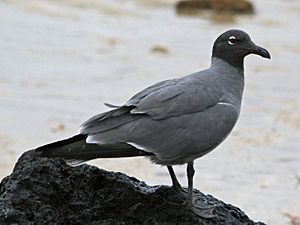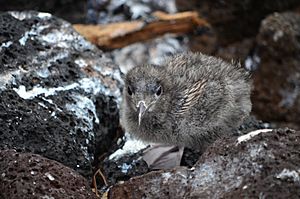Lava gull facts for kids
Quick facts for kids Lava gull |
|
|---|---|
 |
|
| Conservation status | |
| Scientific classification | |
| Genus: |
Leucophaeus
|
| Species: |
fuliginosus
|
 |
|
| Synonyms | |
|
Larus fuliginosus |
|
The lava gull (Leucophaeus fuliginosus), also called the dusky gull, is a special type of gull. It's known for being the rarest gull in the entire world! You can only find this unique bird in the Galapagos Islands, which are famous for their amazing wildlife. It's a medium-sized bird and belongs to a group often called "hooded gulls." This gull is most closely related to the Laughing gull and Franklin's gull.
Contents
Discovering the Lava Gull
The lava gull was first described by a scientist named John Gould in 1841. He found it on Santiago Island in the Galápagos. Sometimes, this bird is placed in a different group called Larus. Scientists think it might be closely related to the laughing gull.
What Does a Lava Gull Look Like?
The lava gull is easy to spot! It's about 51 to 55 centimeters (20 to 22 inches) long and weighs around 380 grams (13 ounces).
Adult Lava Gulls
Adult lava gulls have a dark, sooty brown to black head. Unlike some other gulls, their head color stays the same all year. Their wings are dark gray, but they have a bright white line on the front edge. This white line might help them with showing off or even with camouflage! Their body is dark gray, but their belly is a lighter gray. The top part of their tail is white, becoming grayer lower down.
Their beak and legs are black, and the inside of their mouth is a bright red. They also have white lines above and below their eyes, with red eyelids.
Young Lava Gulls
Young lava gulls are usually dark brown all over.
Where Do Lava Gulls Live?
The entire population of lava gulls lives only on the Galapagos Islands. You can mostly find them on islands like Santa Cruz, Isabela, San Cristobal, and Genovesa.
In 2015, scientists estimated there were only about 300 to 600 lava gulls in the world. This makes it the rarest gull on Earth!
How Lava Gulls Live Their Lives
Reproduction and Nesting Habits
Most gulls like to nest very close to each other, sometimes even touching. But lava gulls are different! They prefer to nest alone. They rarely build their nests closer than 100 meters (about 330 feet) apart.
They are very protective of their nesting areas. They defend territories that are about 2000 square meters (or about 70 meters across) from other gulls. They build their nests on the ground, often hidden under plants near the coast. They line their nests with plant materials.
Female lava gulls lay two olive-colored eggs. These eggs are very well camouflaged, meaning they blend in with their surroundings. The eggs take about 32 days to hatch. Lava gulls usually nest near calm water, like lagoons. They can breed at any time of the year, not just in one season. Young birds are ready to fly after about 55 days. Even after they can fly, their parents continue to care for them for several more weeks.
What Lava Gulls Eat
Lava gulls are omnivores, which means they eat both plants and animals, just like most gulls. They often look for food that others have left behind or even try to steal food from other birds' nests or from fishers.
They also hunt for their own food. They catch fish, small crustaceans (like crabs), and newly hatched lizards, iguanas, and turtles. Sometimes, they even eat sea lion afterbirth. On Genovesa Island, they cleverly take advantage of Magnificent frigatebirds. When frigatebirds try to steal fish from other seabirds and mess up, the lava gulls swoop in to grab the dropped fish!
Threats to Nests
Some animals might try to eat lava gull eggs or chicks. These include owls, frigatebirds, and even other lava gulls. Mammals that have been brought to the islands by humans can also be a danger.
Protecting the Lava Gull
The IUCN Red List has listed the lava gull as "vulnerable." This means they are at risk. There are only a small number of these gulls, and even though their population is stable, they face several threats. Protecting their habitat and ensuring their safety is important for their survival.
See also
 In Spanish: Gaviota fuliginosa para niños
In Spanish: Gaviota fuliginosa para niños




